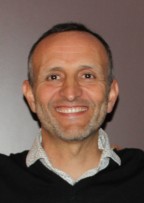- >Accès directs
- >Annuaire
- >F
- >L
- >cyril.fleurant

Cyril FleurantGeographie / LPG
- UFR Lettres Langues et Sciences Humaines - LLSH
- Départements d'Enseignement LLSH - DEP ENS LLSH Géographie
Géographie - A 218
- 0241226456
- 11 Boulevard de Lavoisier - 49045 - ANGERS CEDEX 01
- Géographie
- A 218
- A 218
- Structure Fédérative de Recherche Végétal : SFR QUASAV
- Structure Fédérative de Recherche Végétal : SFR QUASAV - Laboratoire de Planétologie et Géosciences - LPG
LPG - C'204
- 0241735382
- 42 Rue Georges Morel - 49071 - BEAUCOUZE CEDEX 01
- C'204
- Courriel : cyril.fleurant @ univ-angers.fr
Afficher UFR de Lettres, Langues et Sciences Humaines sur une carte plus grande
Discipline
Physical Geography and Environment
Thèmes de recherche
Prof. Cyril Fleurant has an undergraduate degree in applied geology from the University of Bordeaux. He has a Master degree and a D.Phil. on quantitative hydrology and hydrogeology from MinesParisTech (Paris). He held several teaching and research positions at University of Nantes, Ecole des Mines de Nantes and AgroCampus Ouest. Since 2012 he has been a full professor position at the University of Angers (France) - Department of Geography.
Prof. Fleurant's research is pluridisciplinary within research group Laboratoire de Planétologie et Géosciences (UMR 6112 CNRS) and involves projects on geomorphology, hydrology and hydrogeology.
Teaching
Bachelor 1: Introducing physical geography
Bachelor 1: Climate and Climate Change
Bachelor 1: Mathematics and statistics
Bachelor 3: Hydro-geomorphology and hazard
Bachelor 3 : Spatial data analysis in geography
Master 2: Geosystem dynamics
Master 2: Resource management and Energy
Master 2: Modeling hydrology/hydrogeology
Research Fields
Coupling runoff, erosion and pollutant transfer models on small watersheds. Keywords: cellular automata, multi-agents system, DEM, GIS.
- Analysis of the relationships between river basins' landform and rainfall runoff models. Keywords: fractals, self-similarity, self-afinity, transfer function.
- Comparison of geomorphic processes between Namibia pans and Titan lakes. Keywords: dissolution processes, Titan, Namibia, cellular automata.
- Modeling complex systems in physical geography. Keywords: cellular automata, multi-agents system, c++.
- Modeling genes dispersivity on river networks. Keywords: landforms analysis, population dynamics, c++.
-Modeling the genesis of natural and urban landforms: Keywords: fractals, cellular automata.
Codes development
- Fleurant C., Tobie G., Bourgeois O., et S. Le Mouelic, since 2009 and in progress, Titan, (C++), Landscape evolution model of depressions: Namibia vs Titan.
- Fleurant C., 2006-2007-2008-2009, Gene-Net, (C++, QT and Qwt), Individual-based model to simulate dispersal and genes flow in synthetic river networks.
- Tucker G.E, Fleurant C. and A. Dessiter, 2004, contribution to CHILD (Channel-Hillslope Integrated Landscape Development: weathering of carbonates.Fleurant C., 2001a, FRACDIM (C++), Fractal dimension calculation within two numerical methods: density and box counting.
- Fleurant C., 2001b, RW3D3 (Random Walk 3D, version 3: C++), molecular diffusion of particles into a porous media: application to the dissolution of nuclear glasses.
- Fleurant C., 2000, RW3D2 (Random Walk 3D, version 2: C++), molecular diffusion of particles into a porous media: application to chloride transfer into calcretes.
- Fleurant C. and J. van der Lee, 1999, RW3D (RandomWalk 3D: C++), transfer of particles by advection-diffusion into fractured and porous media.
Ph.D. students
- Julie Campagna, 2015-, Modélisation prédictive de l'évolution d'un espace littoral : apport de la télédétection pour appréhender la gestion et les services d'un territoire en mutation ; le cas des étangs et marais des Salins de Camargue.
- Mahefa Rakotoarisoa, 2013-, Étude de l’impact du changement climatique sur les risques hydrologiques dans des bassins versants sous contrôle anthropique : modélisation de l’aléa, de la vulnérabilité et des conséquences sur les sociétés. Cas de la régions Sud-Ouest de Madagascar.
- Clémence Gualt, 2010-2013, Biodiversité des espaces boisés en ville - contribution à l'évaluation écologique des trames vertes urbaines.
- Audrey Chaput-Bardy, 2004-2007, Dispersion et stratégies sexuelles de Calopteryx splendens. Effet de la structure des réseaux hydrographiques, 138 p.
- Budi Kartiwa, 2001-2004, Modélisation hydrologique de petits bassins versants indonésiens, 200 p.
- Bernard Roland, 2002-2004, Bocages : formes du paysage et flux.
CV
2017-2022: Director of UFR Lettres Langues Sciences Humaines
2016-2021: Director of UMR 6554 CNRS LETG-Angers
2012: Professor - University of Angers.
2010: Professor - AgroCampus Ouest.
2010: Professor qualification - CNU sections 23 and 35.
2009: Habilitation - University of Angers.
2003: 1 year visiting academic - Geography Department - University of Oxford (U.K.).
2001: Associate Professor - AgroCampus Ouest.
2001: Associate Professor qualification - sections 35, 36 and 60.
2000: Ph.D. in quantitative hydrology and hydrogeology. UMR CNRS 7619, École Nationale Supérieure des Mines de Paris.
1995: Master in quantitative hydrology and hydrogeology.. UMR CNRS 7619, University P. & M. Curie (Paris 6).

